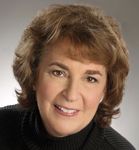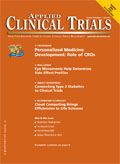Biosimilars Development Raises Research Questions
Applied Clinical Trials
Debate narrows over extent of pre-clinical and clinical testing for follow-on versions of complex biologics.
The Food and Drug Administration (FDA) is working on guidelines for documenting similarity and interchangeability of copycat biotech therapies, seeking to resolve a host of thorny issues. There is general agreement that producing follow-on versions of biotech therapies is vastly more complex than manufacturing conventional generic drugs, and that FDA will require a broader testing program to approve a product as biosimilars or interchangeable. Developing a biosimilar will run up a tab of some $75 million to $250 million and typically take seven to eight years, according to one research expert.

Jill Wechsler
Even so, the prospect of biopharmaceuticals capturing a greater share of the global drug market is attracting interest from a spectrum of pharma and biotech companies. The worldwide market for biosimilars is projected to grow to $3.7 billion by 2015, up from about $250 million last year, according to Datamonitor, as more biotech patents expire and regulatory authorities clarify requirements for testing and approving follow-ons. Sponsors talk of marketing biosimilars at discounts of 25 to 30 percent off branded products, but payers say that prices that are just 10 percent lower will be able to gain market share, particularly for therapies with high price tags to begin with.
Setting a pathway
FDA officials are under pressure from Congress, government agencies, and payers to establish an abbreviated regulatory pathway for approving biosimilars, as authorized by the Biologics Price Competition and Innovation Act (BPCIA), which was included in the Affordable Care Act of 2010. The aim of Congress is to reduce spending on prescription drugs by permitting "highly similar" versions of biotech therapies to come to market based on less extensive data than required to approve the original reference drug. FDA held a public meeting last November to launch the process for developing biosimilars that meet standards for product safety, purity, and potency. The new follow-on drug has to have the same mechanism of action, route of administration, dosage form and strength, and avoid "clinically meaningful differences" with the reference product.
Janet Woodcock, Director of the Center for Drug Evaluation and Research (CDER), recently indicated that general guidance should appear this year, and that its requirements for human testing will vary according to how well a biosimilar can document sameness to the innovator product. Biosimilarity will be based on molecular structure and in vitro assays, as well as pre-clinical pharmacology and toxicology studies and pharmacokinetic and pharmacodynamic testing in humans. In addition, clinical studies generally will be needed to support equivalent efficacy in at least one approved indication. Yet, even innovator firms acknowledge that a biosimilar pathway most likely will require less animal toxicity studies and probably no dose finding and Phase II clinical trials. Equivalence and non-inferiority trials would utilize active controls instead of placebos, for ethical as well as practical reasons.
At the same time, FDA is moving forward with a user fee schedule for biosimilars. The agency has proposed application fees similar to those for innovator drugs and biologics, but with a new approach to help finance FDA's extensive involvement in steering sponsors through the development process. The plan is for sponsors to pay a product development fee of $150,000 when they submit an investigational new drug application and annually thereafter; those upfront payments then would be subtracted from the eventual application fee.
Even without published guidance, FDA officials say they're ready to evaluate biosimilar applications on an individual basis. "We were open for business a year ago," said Steven Kozlowski, Director of CDER's Office of Biotechnology Products, at the "Future of Biosimilars" conference in May, jointly sponsored by the Drug Information Association and the Food and Drug Law Institute. So far no sponsors have tested the 351(k) approval route authorized by the BPCIA, but many are talking to FDA, while keeping a close watch on the policy process.
A very basic issue is which biopharmaceutical products fall under the new regulatory program. The BPCIA extends the definition of biologics to proteins, as of March 2020. That raises questions about how the change will affect manufacturers of some proteins long regulated as drugs, and how sponsors should proceed during the nine-year transition period.
A thorny issue is whether FDA can approve a biosimilar based on a reference product that is approved overseas, but not in the United States. The BPCIA says that reference products have to be licensed by FDA. Sponsors of global biosimilar development programs object, though, that they can't have every country or region requiring local trials using locally sourced products, explained John Pakulski, Head of US Biopharmaceutical Regulatory Affairs at Sandoz. He and other biosimilars developers want to be able to use foreign reference products in certain circumstances, as when they are made by a US manufacturer or in a facility inspected by FDA; licensed in a highly regulated market such as the Europe or Japan; or have a sufficient postmarketing history to confirm safety, purity, and potency. Additional scientific data could be required by regulatory authorities on a case-by-case basis to establish comparability between a US- and a foreign-sourced reference product.
Another contentious topic is whether biosimilars sponsors can extrapolate data from a clinical study to other indications of the reference product. European regulatory authorities permit this if the added indication involves the same mechanism of action and receptor, and if extrapolation of immunogenicity data applies to a lower-risk population or route of administration. Biosimilars sponsors say that extrapolation may be appropriate if supported by open label safety studies for each indication.
Interchangeability and coverage
A key challenge for FDA is to define interchangeability testing requirements and when switching studies will be required to meet that standard. Biosimilars makers note that switching studies are not required for innovator manufacturers to document comparability following post-approval changes. Yet, innovators maintain that clinical studies in multiple populations are necessary to ensure safety and efficacy with product switching. Amgen Vice President Anthony Mire-Sluis wants head-to-head studies to compare immunogenicity between reference and follow-on biotechnology products, along with product labels that state a product's approved indications and whether the therapy is interchangeable for that indication.
The potential for product naming and coding to drive coverage and reimbursement has generated heated debate on those issues. Innovator firms maintain that biosimilars and brand products require different names to ensure traceability of adverse events, to reduce confusion about interchangeability, and to avoid dispensing errors. Biosimilars advocates prefer names linked to reference products to indicate that the products are related. Innovators also want biosimilars to have their own reimbursement codes, while biosimilars makers want the same code for a drug class.
But even without interchangeability status and common codes, attorney Laura Loeb of King & Spalding predicts that formulary committees and state Medicaid programs will encourage biosimilar prescribing through formulary placement, higher co-pays, prior authorization, and step therapy approaches. "The burden will be on the reference product to prove superiority to the biosimilar," Loeb observed, "not the other way around."
Exclusivity still controversial
Although the BPCIA authorized 12 years of data exclusivity for innovator biologics, during which FDA cannot approve a product based on innovator studies, that has not ended the debate over what is an appropriate exclusivity period to support biotech innovation. Biosimilars sponsors also have to wait four years to even submit a 351(k) application to the agency following first licensure of a reference product. Biotech companies consider those protections vital for encouraging investment in R&D, but critics claim that 12 years is too long. The Obama administration recently proposed reducing exclusivity to seven years, partly to cut costs. A related aim is to prevent patent "evergreening" by innovators that modify a product enough for it to qualify as "new." FDA has to define what changes would sufficiently impact a product's safety, purity, or potency to warrant extended exclusivity.
The legislation also establishes a highly complex patent dispute resolution system that requires biosimilars makers to hand over dossiers to the reference product firm as a way to identify those patents the innovator feels may be infringed. This "hokey-pokey process," explained Sidley Austin attorney Jeffrey Kushan, was designed to promote early agreement on which patents will be disputed, but the new policy seems to please no one. Biosimilars makers fear that too many parties will gain access to their confidential regulatory filings, while BLA-holders stand to lose protection if they don't follow the rules.
If this and other policies make the biosimilars pathway appear too costly and treacherous, sponsors may avoid the 351(k) process altogether and decide to take the traditional BLA route to market—with its 12 years product exclusivity.
Jill Wechsler is the Washington Editor of Applied Clinical Trials, (301) 656-4634 jwechsler@advanstar.com

FDA Fast Tracks Johnson & Johnson’s Nipocalimab for Fetal Neonatal Alloimmune Thrombocytopenia
March 27th 2024Johnson & Johnson is moving forward with a pair of Phase III trials of nipocalimab to reduce the risk of fetal neonatal alloimmune thrombocytopenia in alloimmunized pregnant patients.